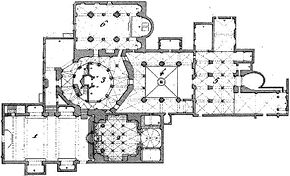19061302
|
1230
| |
San Stefano
...the Basilica of St. Stefano, Bologna, thirteenth century, a religious compound where the Court of Pilate and the Church of the Holy Sepulcher, Jerusalem were/are specifically reenacted.

1. The six churches of which the plans are here given, nos. 1 to 6, are thus grouped at Bologna, under the title St. Stephen, the church no. 1, however, being more particularly dedicated to the saint.
2. Subterranean Church of S. Lorenzo, beneath that of St. Stephen, and serving as the Confession.
3. Church of the Holy Sepulchre; according to tradition the baptistery of St. Peter and St. Paul, no. 6, the first cathedral built at Bologna.
4. Another church, called the Court of Pilate.
5. Church of the Trinity.
6. Church of St. Peter and St. Paul.
The evolution from the Early Christian "martyrium group" to the medieval "compound martyrium" has run as a leading theme through our discussion. We return to it once more with two monuments marking this evolution in a curious contrast of medieval possibilities. At the twelfth-century complex in Bologna known as S. Stefano the whole range of buildings at the side of the Holy Sepulchre was reproduced in a famous medieval "Jerusalem." The layout is much older, but the present structures (much restored) date from about 1150. Anastasis, Golgotha, and Martyrion face each other across an arcaded courtyard. A few characteristic elements of the original were selected and combined freely, as is usual in medieval "copies," but the source is unmistakable. At almost the same time the original complex at the Holy Sepulchre in Jerusalem itself--or what remained of it--was "medievalized." The Anastasis rotunda, Golgotha, and Martyrion and all surrounding sites were enveloped within the fabric of the "Crusader's Church," dedicated in 1149. The marturium group par excellence had become a compound martyrium.
Howard Saalman, Medieval Architecture: European Architecture 600-1200 (1962), p. 41.
| |
1986-
| |
Mayor's House
| |
|